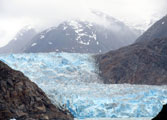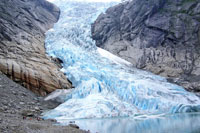  Glacier Facts for Kids Glacier Facts for Kids
Check out our fun glacier facts for kids and enjoy a wide range of interesting information about glaciers. Read how glaciers are formed, why studying glaciers is so important, what the different types of glaciers are, how much of Earth's freshwater sit with glacial ice, and much more. | | |
As glaciers move they erode the terrain under them using two main processes. Plucking, whereby bedrock rock is softened and levered out by subglacial water constantly re-freezing (expanding) within it, the sediment then becomes part of the glacier's cargo. Abrasion occurs when the ice and now rock too slides over the bedrock essentially smoothing and polishing it like sandpaper on wood.
Usually mountain valleys are “V” shaped. Glaciers deepen, smooth and widen the valleys into a "U" shape. Within these glacial valleys, depressions and deposits left behind are filled by water to create lakes and fjords.
Types of glaciers include: Alpine glaciers (or mountain glaciers) located in mountain valleys. Ice caps (or ice fields) are less than 50,000 km² (20,000 mi²) in size and sit on top of mountains. While ice sheets (or continental glaciers) are usually found at the poles and are larger than 50,000km².
|

|
|